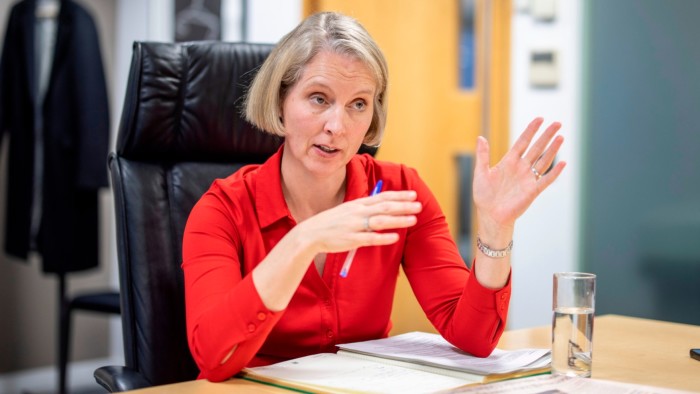Government could force pension funds to invest more in UK assets

Emma Reynolds, UK pensions minister, has left the door open to forcing pension schemes to invest more in British assets if reforms fail to drive savings into domestic infrastructure and companies.
The government announced this week it would create a series of “megafunds” to steer more of the UK’s £1.3tn defined contribution and local authority pension industry into productive domestic finance.
Reynolds said that while ministers had not taken steps to force pension funds to invest in British assets, it could reconsider “mandation” if the measures did not boost pension investment in the UK.
“We’re not talking about it for now, but let’s see where we get to,” Reynolds said, in an interview with the Financial Times. “Investment in pensions is, as you know, very generously provided for in terms of tax relief.”
Reynolds added that a decision to take further measures to push a higher allocation to the UK would be “left to the second bit” of the pensions investment review.
The government has laid out proposals to create pools of pension assets of at least £25bn across local government and defined contribution pension schemes, which it said would release up to £80bn of private capital for infrastructure and scale up businesses.
Reynolds said she was being realistic and was not saying that a majority of the extra investment should go into British assets, but added: “I need more of it than currently comes to come to the UK.”
UK pension savers have a relatively low allocation to their home market compared with other pension systems.
Just 4.4 per cent of UK pensions are held in domestic equities, much lower than a 10.1 per cent global average. In private markets, DC schemes allocate just 2 per cent to unlisted British equities and infrastructure, rising to only 10 per cent for local government pension schemes.
“We are an outlier in terms of our own pension schemes,” Reynolds said. “We’d like more UK pension investment into our own economy”.
Her warning comes as the government has announced the most radical overhaul to the UK pension industry since the so-called “pension freedoms” changes of 2015. These allowed people over 55 to withdraw cash from their funds.
At the heart of Reynolds’ plan to drive more investment into Britain are proposals to make the 86 councils of the local government pension scheme of England and Wales hand over all of their assets — and investment decision-making — to one of eight asset pools by March 2026.
“We are going to be much, much more prescriptive as to what pooling means and how you pool and the assets that you have should be managed at pool level because that will drive better returns,” Reynolds said.
Town halls — forecast to manage £500bn of pensions savings by 2030 — started the process of consolidating assets in 2015, but a lack of guidance on how the pools should operate has led to slow adoption and a range of different models.
“We want to professionalise the pools and drive economies of scale . . . the bigger the pools, the better the governance, the better deals they can drive,” she said.
Some in the pensions industry don’t agree. Quentin Marshall, chair of the Kensington and Chelsea council pension fund, the best-performing LGPS fund over the past five years, said: “I don’t buy into the idea that there’s a huge economy of scale to be had in order to drive better returns . . . I think they will create big bloated unaccountable quangos.”
The government is also looking to overhaul DC workplace pension schemes, which manage the retirement savings of most private sector workers and are expected to manage £800bn by the end of the decade.
Reynolds said assets of £25bn would be “the minimum” for multi-employer schemes. “The overall vision is fewer, bigger, better run. Pension schemes that can drive better deals, can bear down on costs and benefit from economies of scale.”
The proposals are expected to prompt a flurry of mergers across workplace pension schemes.
Reynolds said the government was working on ensuring that there were enough attractive assets in the UK for pension schemes to invest in with the help of the National Wealth Fund, the British Business Bank and a big overhaul of planning rules.
It was “difficult to say” if pension schemes would have performed better if they had invested as she would have liked over the past decade — as this was about having larger funds with more exposure to private equity and infrastructure.
But she was adamant that the outcomes for savers remained at the core of the government’s plans.
“Obviously on the master trust side they have fiduciary duty and on the contract side they have the consumer duty and all sorts of other requirements to make the best investment for their members . . . that will remain the case,” she said.
“I’m not an investment manager — I’m a politician — I’m not going to tell them how to invest. But we do want them to think about value over time rather than, you know, how much is this going to make this year.”
Asked why chancellor Rachel Reeves had decided not to save some money in her Budget by cutting the £268,275 maximum tax-free lump sum that can be withdrawn from a pension, Reynolds said: “We didn’t go down that road.
“We’ve got to strike the right balance here between raising revenue and also making sure the right incentives are in the system for people to save for the long term.”
#Government #force #pension #funds #invest #assets




